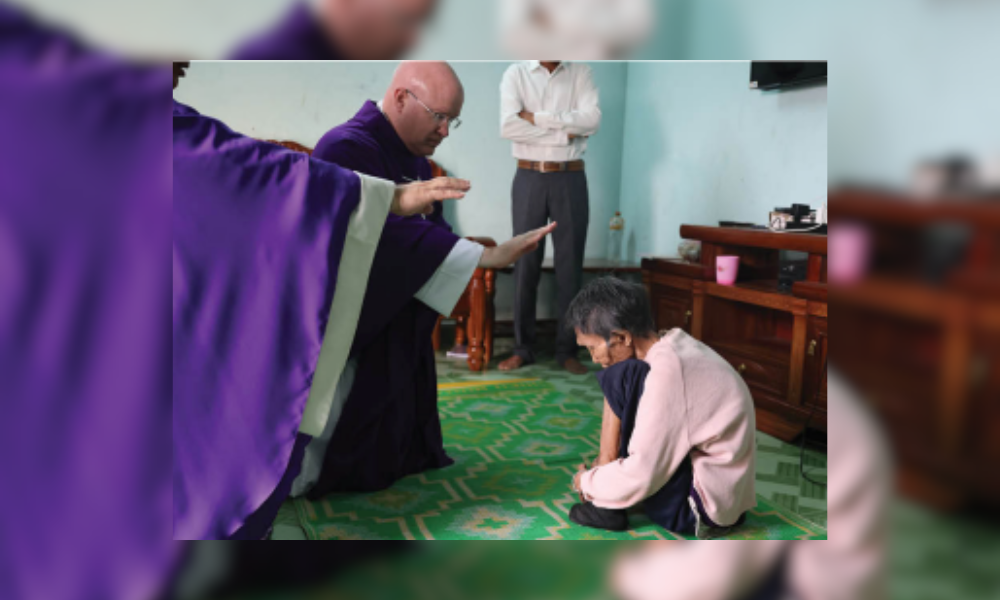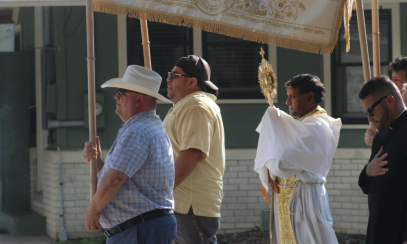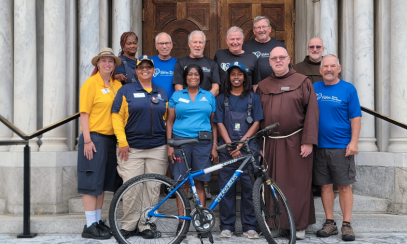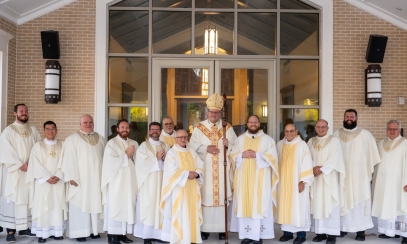
Our Lady of the Lepers
Getting your Trinity Audio player ready...Father Tri’s mission in Kon Tum has led him to a special devotion for Our Lady of Mǎng Ðen, a mysterious statue with a missing nose and broken hands –– discovered by accident after the Vietnam War.
Father Tri’s mission in Kon Tum has led him to a special devotion for Our Lady of Mǎng Ðen, a mysterious statue with a missing nose and broken hands –– discovered by accident after the Vietnam War.
The image, a replica of Our Lady of Fatima, was brought to the area during the war, in 1971. The small statue was damaged due to bombings, and eventually forgotten, when the surrounding area became desolate as the people in the villages left. The image remained there, lost in the jungle until 2006. The government had gone into the highlands to develop roads, but the Virgin had other plans. When reaching within a mile of the site of the lost statue, excavation machinery continuously broke down for unknown reasons.
“During road construction, machinery kept breaking down near a hidden spot in the forest. Eventually, workers found a statue buried in the weeds –– its face deformed, its hands missing. They tried to restore it, but the repairs never held.”
People began to see a deeper meaning. Our Lady, just as she has in countless apparitions, seeks to resemble those who need her most.
“She was like the people in the leprosy colonies –– disfigured, rejected, but still full of grace. That’s why they call her Mother of the Lepers. They know she understands.”
Leprosy Is Not Just in the Bible –– And Not Just in Vietnam
Leprosy –– also known as Hansen’s Disease –– may sound like a condition from biblical times, but it is still a painful reality for thousands of people today, particularly in some of the world’s poorest and most isolated communities.
A Disease with Ancient Roots
In the Gospels, Jesus encounters and heals people with leprosy –– a term then used broadly for visible skin conditions that caused social and religious exclusion. In ancient Israel, lepers were shunned, declared ritually unclean, and forced to live apart from society.
Today’s leprosy, Hansen’s Disease, is a chronic infectious illness caused by a slow-growing bacterium, Mycobacterium leprae. It primarily affects the skin, nerves, and eyes, and if left untreated, can lead to deformities, nerve damage, and disability. Many loose limbs after living with this painful disease for years.
But there’s good news: leprosy is now curable with regular multidrug therapy over 6 to 12 months. The World Health Organization provides treatment for free –– yet many people living in remote or marginalized communities still go undiagnosed, untreated, or live in shame and fear.
Not Just in Vietnam
Vietnam is one of more than 120 countries that still report new cases of leprosy each year. While leprosy is rare in the US, with around 225 new cases reported annually out of the global 200,000, it remains endemic in many parts of the world, particularly in South Asia and Central Africa.
In many of these places, those affected live in colonies or villages far from medical care, often rejected by society and cut off from the sacrament.
The Church Has Always Been There
From the time of Christ to today, the Catholic Church has been at the forefront of ministering to those with leprosy –– not only by providing medical care but by restoring dignity through presence, accompaniment, and sacramental life.
One of the most famous missionaries to leprosy patients was St. Damien of Molokai, a Belgian priest of the Congregation of the Sacred Hearts. In the 19th century, he volunteered to serve on the Hawaiian island of Molokai, where leprosy patients were forcibly exiled. He lived among them, built chapels and houses, touched the untouchable, and eventually contracted the disease himself. He died in 1889 and was canonized in 2009.
Others have followed in his footsteps, like St. Marianne Cope, a Franciscan sister who also served in Hawaii, and missionaries around the world today –– from the highlands of Vietnam to rural India and East Africa –– who carry out the work of mercy with compassion, creativity, and Eucharistic love.
The Mission Continues
The Pontifical Mission Societies support many of these efforts in mission dioceses where leprosy remains present. Today, missionaries like Father Tri Pham and religious sisters across Vietnam continue this legacy –– not only by offering medical assistance, but by reminding those afflicted that they are not forgotten.



